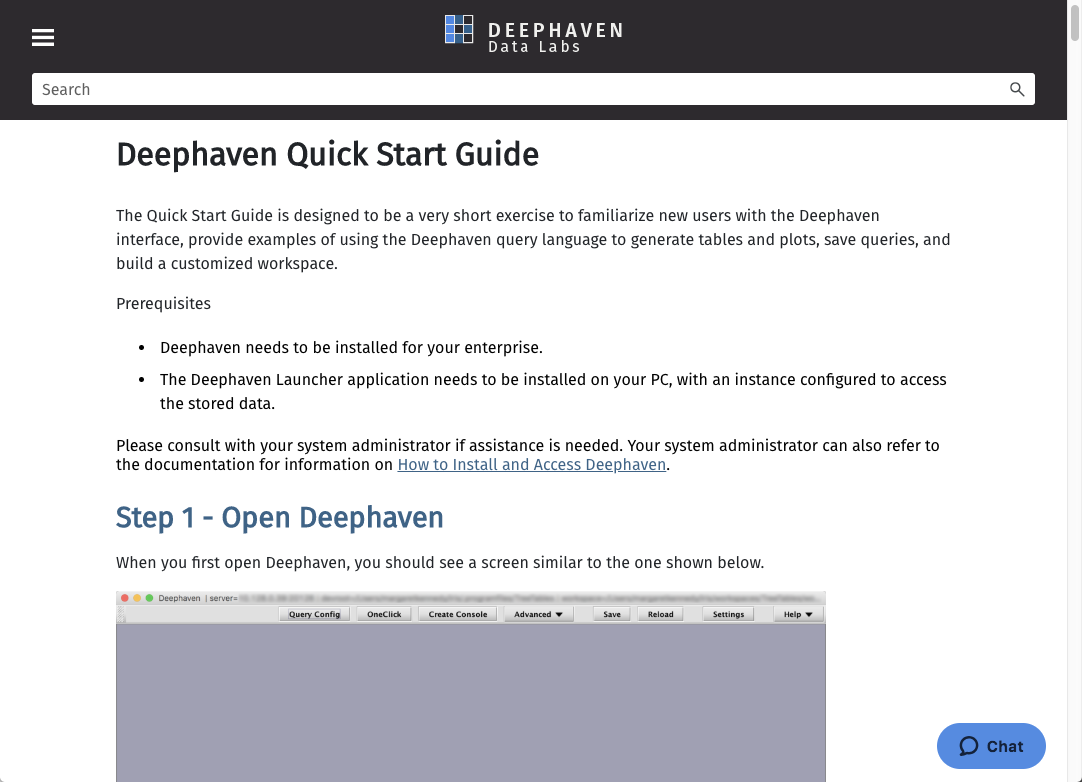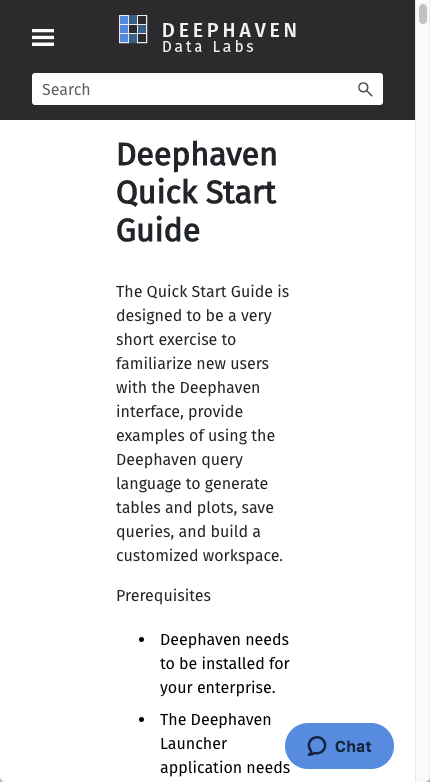Introduction
Welcome
Deephaven is built specifically to address the challenges of working with and gleaning value from big data – both historical and real-time. We knew this was going to be a challenge, so we re-imagined and re-engineered everything related to bringing big data to the masses. After years of fine-tuning, iteration and real-life use in the demanding global financial markets, the vision became reality.
Deephaven is a powerful, simple and expressive programming language seamlessly integrated with a massive, high performance database and an intuitive user interface.
Prerequisites to Using Deephaven
Personal
Like most activities these days, having competency with computers and software is a requirement. You should be able to use a mouse or trackpad, type on a keyboard, read a monitor, use a web browser, etc. If you are reading this now, you have already proven you have those skills.
If you can use spreadsheet software like Microsoft Excel, you can use Deephaven. In fact, the logic used in creating and writing spreadsheet formulas is very transferable to Deephaven. However, Deephaven scales with your skills. Basic programming skills, especially in Groovy and Java, will flatten your learning curve and expedite your proficiency with Deephaven.
System / Software
The Deephaven client is an application created primarily in Java. As such, it can operate on many different operating systems and devices. Recommendations follow:
- Minimum Hardware Recommendations
- CPU: 2.0+ Ghz single-core
- RAM: 4+ GB
- Disk Space: 150 MB
- Operating System Requirements
- Windows 7+
- Mac OS X 10.2+
- Linux: Any 64-bit, kernel version 2.6+
- Software
- Java 1.8 or newer
How this Documentation is Organized
The Deephaven documentation is designed to be read in a linear fashion. However, its interactive design allows you to easily jump to any specific topic or subject. The Search feature enables you to target a given keyword or phrase.
The Deephaven User documentation is divided into the following sections:
- Introduction is what you are reading now, and is intended to give you a very brief intro to this documentation, the video tutorials and more.
- Getting Started provides an overview of the Deephaven interface, and introduces you to some core concepts and basic programming ideas. It also provides instructions for installing Deephaven on your computer.
- The User Interface presents a full description of how you can interact with Deephaven. It tells you how to work in the Console, configure persistent queries, customize your workspace and much more.
- Working with Tables contains information about manipulating data and tables in the Deephaven user interface.
- Working with Plots has information about creating charts in the Deephaven user interface.
- Writing Queries shows you how to bring your data analyses to life. In this section, you can walk through some sample queries and then jump right into your own. You will learn how to access data tables, and then apply table operations like Filtering, Selections, Sorting, Grouping, and Aggregation.
- Troubleshooting Queries provides information that enable users to monitor query performance and resolve issues should they arise.
- Plotting Methods provides the many options available in Deephaven for visualizing your data through the use of charts.
- Advanced Topics shares information about Custom Actions and defining tables for import through Schemas.
- Video Tutorials presents a collection of videos you can use to learn various aspects of Deephaven.
How to Use this Website
The Deephaven Documentation website is created using responsive design techniques. This means you can navigate through the topics and read the content using any modern browsing application on most common devices ranging from computer monitors to tablets to mobile phones.
If you are reading this now on a monitor, and have the browser set to full width, you will see the expandable topic list on the left side of the browser window, similar to what is shown below.
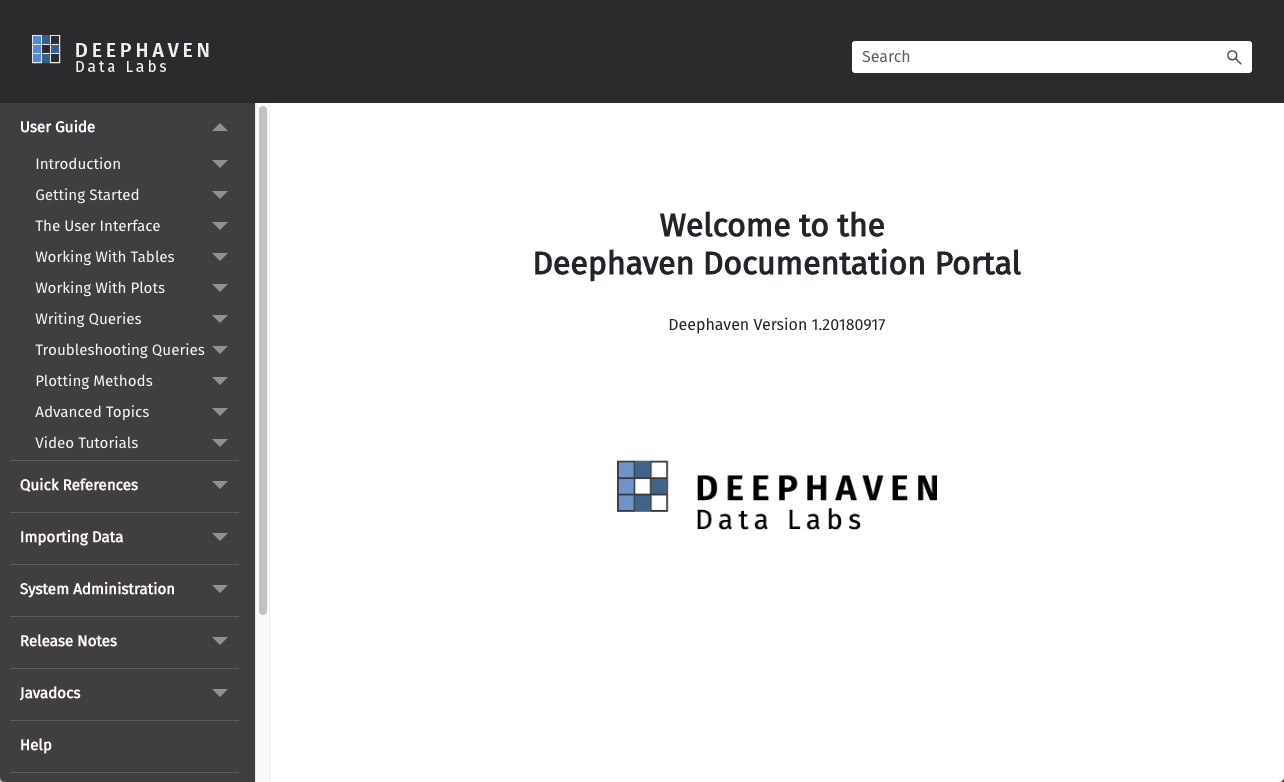
If you have reduced the width of the browser window, or if you are using a tablet or cell phone, the topic list will not be visible on the left side, as shown below.
|
|
|
When the screen width is too small to show the topic list, you can click on the "hamburger" icon in the top left corner to expand the search and topic listings.
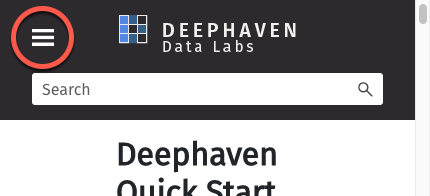
That will expand the left side to show the navigation/selection column, where you can expand the topic list or go back one level higher.
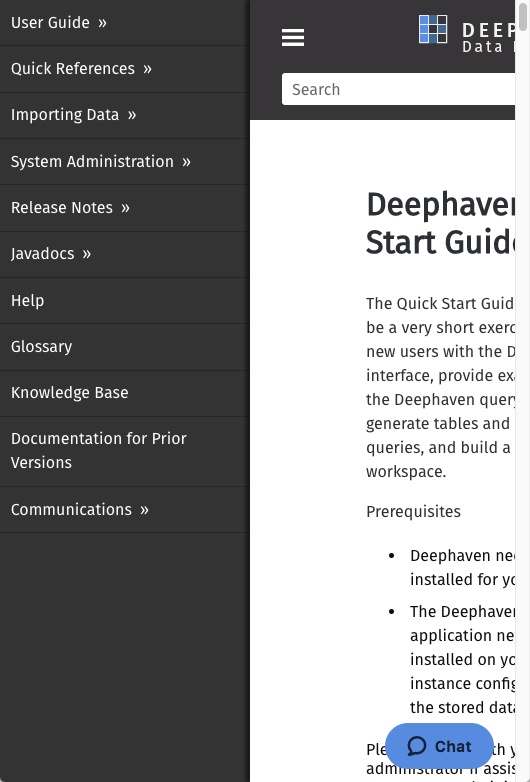
|
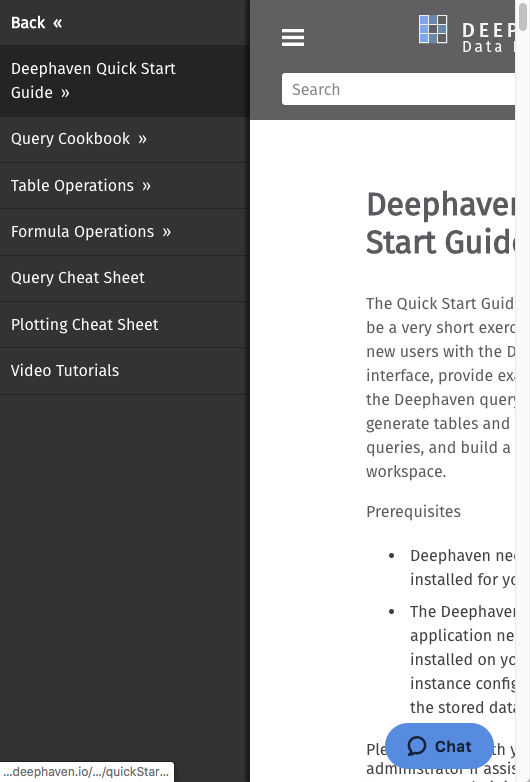
|
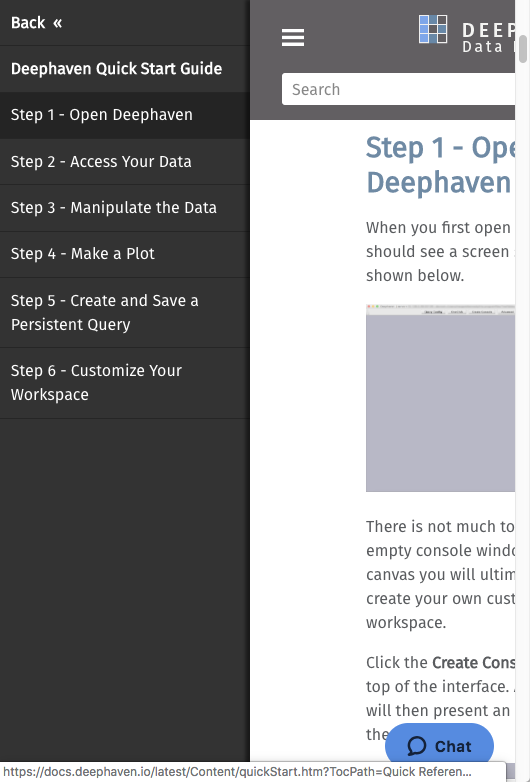
|
All documentation is updated on a regular basis to document new features and/or enhancements. However, if you do find an error or see a typo of some kind, please let us know by sending an email to [email protected]. Or, click the blue Chat button in the lower right corner of this window.
Style Conventions Used in this Documentation
Bold
Bolded text is generally used to refer to certain keys on a keyboard or aspects of the user interface, e.g., the Enter key or the Back button.
Italics
Italicized text is typically used in this documentation for emphasis or to indicate file names and file path names, e.g., /db/TempFiles/dbquery/workspaces/.
Underlined
Underlined text is used to indicate an interactive link, including website URLs and email addresses, e.g., www.deephaven.io, or [email protected].
Fixed-width Font
Fixed-width fonts are used in this documentation to indicate anything that you would literally type when programming.This includes keywords, data types, constants, methods, variables, class names, and any other Java, Groovy or Python code.
Tell us what you think.
Our goal is to continuously improve our products, and user satisfaction is Deephaven's top priority. We want to know what we are doing right and what we could do better.
Do you have suggestions for product enhancements or new product features? Perhaps you've found an error in the documentation or our videos. Or maybe you'd like to see additional information on a specific topic. Let us know by sending an email to [email protected].
We are here to help.
If you need assistance using Deephaven, help is just a click away. Support is provided via live chat and via email.
- Live Chat Support: Click the Chat button at the bottom right corner of this web page (Live Chat is available during business hours only)
- Email Customer Support: [email protected]
See also: Contacting Customer Support
Last Updated: 10 July 2019 09:57 -04:00 UTC Deephaven v.1.20181212 (See other versions)
Deephaven Documentation Copyright 2016-2019 Deephaven Data Labs, LLC All Rights Reserved
